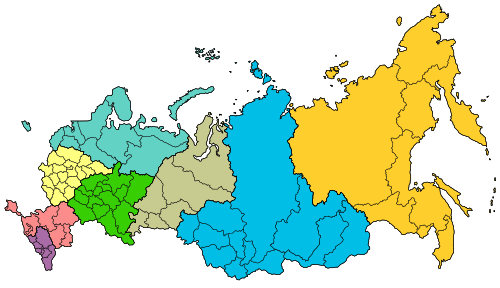Federal districts of Russia
The federal districts (Russian: федера́льные округа́, federalnyye okruga) are groupings of the federal subjects of Russia. Federal districts are not provisioned by the Constitution of Russia and are not the constituent units of the country, but exist purely for the convenience of operation and governing by federal government agencies. Each district includes several federal subjects and each federal district has a presidential envoy titled a Plenipotentiary Representative of the President of the Russian Federation in a Federal District.
The federal districts and positions of Plenipotentiary Representatives were originally created in 2000 by Presidential Decree "to ensure implementation of the President of the Russian Federation of its constitutional powers".[1] Plenipotentiary Representatives are appointed by the President and are employees of the Presidential Administration.
List of federal districts

| Federal district[2] | Establishment date |
Area (km²)[3] |
Population (2010 Russian Census) |
Federal subjects |
Administrative center |
Presidential plenipotentiary envoys |
Continent | |
|---|---|---|---|---|---|---|---|---|
| Central | May 18, 2000 | 650,200 | 38,438,600 | 18 | Moscow | Alexander Beglov | Europe | |
| South[lower-alpha 1][4] | May 18, 2000 | 427,800 | 16,141,100[lower-alpha 2] | 8 | Rostov-on-Don | Vladimir Ustinov | Europe and Asia | |
| North West | May 18, 2000 | 1,687,000 | 13,583,800 | 11 | Saint Petersburg | Nikolay Tsukanov | Europe | |
| Far East | May 18, 2000 | 6,169,300 | 6,291,900 | 9 | Khabarovsk | Yury Trutnev | Asia | |
| Siberia | May 18, 2000 | 5,145,000 | 19,254,300 | 12 | Novosibirsk | Sergey Menyaylo | Asia | |
| Ural | May 18, 2000 | 1,818,500 | 12,082,700 | 6 | Yekaterinburg | Igor Kholmanskikh | Europe and Asia | |
| Volga | May 18, 2000 | 1,037,000 | 29,900,400 | 14 | Nizhny Novgorod | Mikhail Babich | Europe and Asia | |
| Northern Caucasus | January 19, 2010 | 170,400 | 9,496,800 | 7 | Pyatigorsk | Oleg Belaventsev | Europe | |
Source:[6]
History
President Vladimir Putin established seven federal districts in May 2000.[7]
On January 19, 2010 the new North Caucasian Federal District split from the Southern Federal District.[6]
On March 2014, after the Russian military intervention in and annexation of Crimea, the Crimean Federal District was established.[8] The legality of this annexation is disputed by most states as well as NATO.[9] On July 28, 2016 the Crimean Federal District was abolished and merged into the Southern Federal District in order to "improve the governance".[10]
Presidential plenipotentiary envoys
- Central Federal District
- Alexander Beglov (since May 23, 2012)
- Southern Federal District
- Vladimir Ustinov (since May 12, 2008)
- Northwestern Federal District
- Nikolay Tsukanov (since July 28, 2016)[11]
- Far Eastern Federal District
- Yury Trutnev (since August 31, 2013)[12]
- Siberian Federal District
- Sergey Menyaylo (since July 28, 2016)[13]
- Ural Federal District
- Igor Kholmanskikh (since May 18, 2012)
- Volga Federal District
- Mikhail Babich (since December 15, 2011)
- North Caucasian Federal District
- Oleg Belaventsev (since July 28, 2016)[14]
See also
- Economic regions of Russia, a similar grouping of the federal subjects of Russia for economic and statistical purposes.
- Military districts of Russia, a similar grouping of federal subjects of Russia for military purposes
References
- ↑ УКАЗ Президента РФ от 13.05.2000 N 849 "О ПОЛНОМОЧНОМ ПРЕДСТАВИТЕЛЕ ПРЕЗИДЕНТА РОССИЙСКОЙ ФЕДЕРАЦИИ В ФЕДЕРАЛЬНОМ ОКРУГЕ". Graph.document.kremlin.ru (2000-05-13). Retrieved on 2013-08-20.
- ↑ "Russia: Federal Districts and Major Cities". City Population. Retrieved 24 April 2016.
- ↑ "1.1. ОСНОВНЫЕ СОЦИАЛЬНО-ЭКОНОМИЧЕСКИЕ ПОКАЗАТЕЛИ в 2014 г." [MAIN SOCIOECONOMIC INDICATORS 2014]. Regions of Russia. Socioeconomic indicators - 2015 (in Russian). Russian Federal State Statistics Service. Retrieved 26 July 2016.
- ↑ Putin signs set of laws on reunification of Crimea, Sevastopol with Russia
- ↑ http://en.krymedia.ru/society/3365334-Results-of-Census-Population-of-Crimea-is-2284-Million-People
- 1 2 Президент Российской Федерации. Указ №849 от 13 мая 2000 г. «О полномочном представителе Президента Российской Федерации в федеральном округе». Вступил в силу 13 мая 2000 г. Опубликован: "Собрание законодательства РФ", №20, ст. 2112, 15 мая 2000 г. (President of the Russian Federation. Decree #849 of May 13, 2000 On the Plenipotentiary Representative of the President of the Russian Federation in a Federal District. Effective as of May 13, 2000.).
- ↑ "The Russian Federation". BackGround Places. Russia Profile. Archived from the original on November 6, 2013. Retrieved 5 November 2013.
- ↑ "В России создан Крымский федеральный округ". RBC. March 21, 2014.
- ↑ "NATO Secretary-General: Russia's Annexation of Crimea Is Illegal and Illegitimate". Brookings. March 19, 2014. Retrieved September 29, 2014.
- ↑ "Крымский федеральный округ включен в состав Южного федерального округа" (in Russian). Interfax. 28 July 2016. Retrieved 28 July 2016.
- ↑ "Владимир Путин назначил калининградского губернатора Николая Цуканова полпредом в Северо-Западном федеральном округе" (in Russian). Echo of Moscow. 28 July 2016. Retrieved 28 July 2016.
- ↑ Ульянова, Жанна; Яна Милюкова (August 31, 2013). Дальнему Востоку подобрали нового управленца (in Russian). Gazeta.ru. Retrieved 21 April 2014.
- ↑ "Путин освободил Меняйло от должности губернатора Севастополя" (in Russian). Echo of Moscow. 28 July 2016. Retrieved 28 July 2016.
- ↑ "Путин подписал указ «О полномочном представителе президента РФ в Северо-Кавказском федеральном округе»" (in Russian). Echo of Moscow. 28 July 2016. Retrieved 28 July 2016.